|
THE CARTRIDGE COLLECTOR'S EXCHANGE |
| Contents
Cartridge
Lists
Prior Picture Pages:
Links to Other Sites
Cartridge Collectors Organizations:
Auctions:
Books:
Other Collector's Sites: |
Home of the Old Ammo Guy's Virtual
Cartridge Trading Table Featuring a wide range of antique, obsolete, and modern ammunition for collectors Picture Page February 2007 A full box of 12mm Perrin cartridges........
.
.
. . . . . . . . . . . . . . Unfinished experimental aluminum .223 cases........
. The unfinished .223 cartridge case in this picture is made of aluminum and, as its headstamp (CCI 86) attests, was made by Cascade Cartridge Inc (Omark) in Lewiston, Idaho in 1986. These aluminum cases were experimented with by the company while trying to develop a low cost blank cartridge. Designated the XM941 blank, both headstamped and unheadstamped examples were produced. Besides not being necked or cut to length, the primer pocket on this case has not been vented, and has a protrusion in the center of the pocket that makes it appear to be intended for a Berdan Primer. A shot of the full box is shown below. It is unmarked, and while it appears to be intended for 20 cases, it will hold only 18. There is not room enough to include two more cases without damaging the box. David Hughes included a picture on page 272 of his book The History & Development of the M16 Rifle & Its Cartridge showing one of these unfinished cases and 95 variations of the experimental aluminum cased blank cartridges that were produced by Omark. . . . . . . . . . . .
. .
. . . . . . . . . . .
. . . . . . . Two early Frankford Arsenal .45-70 boxes....
Unfortunately, one of these boxes is not what it initially appears to be,
having probably been made within the last 30 years rather than 131 years
ago. I'm reluctant to call this September 1875 rifle cartridge box a
reproduction. Although it has in a convincing wrapper with
very accurate printing, the construction of the box is not correct. It is
obvious in the picture that the box is of the two piece lift-off-top
style, whereas the military boxes of this period were made up of seven parts (ends, top, bottom,
back, and two piece front) that were held together by the glued-on labeled
wrapper. A
pull string was included which would tear the wrapper at the ends of the top
and across the front, allowing the
Also made more apparent in this end view photo is the difference in the heights as well as shapes of the two boxes. All cartridges in 1875 used 405 grain bullets which were seated to the same depth, resulting in rifle and carbine cartridges that were identical in their external characteristics, and once out of their boxes could only be differentiated by weighing them due to their not being headstamped. Since the rifle and carbine cartridges were the same length, it would follow that the two boxes should be about the same height (allowing a small amount of additional height required for the box with the angled top and bottom) which they aren't. Although now torn, the wrapper is still sealed at the ends of the reproduction box (on the left in the picture) as it was when first applied, and the match-up of the torn edges indicates that it was never any taller than it is in the picture. The length of one of the cartridges is about 1.57"; the outside height of the box is 2.51", indicating that the box could not have held the cartridges that the label indicates were in it.
The quality of the label is impressive, as it has the intricate details
of the original (shown on the top in this and the following picture). These
details include the presence of the fine shading lines within the
'curlicues' in the border, and the matching style and size of the font. That
the label is so right and the box so wrong leads me to believe that this is
either an original label, or a reproduction of an original using a
photographic process, that someone with little knowledge of the original
boxes has applied to this box. If the label is a
I'd be interested in hearing from others who have seen similar questionable boxes, or know of anyone who reproduced or sold high quality.45-70 box wrappers such as this one. I have been told that it is possible this label may have been one that was made around 1980 by the late Bob Hill, co-author of The .45-70 Springfield. . . . .
|

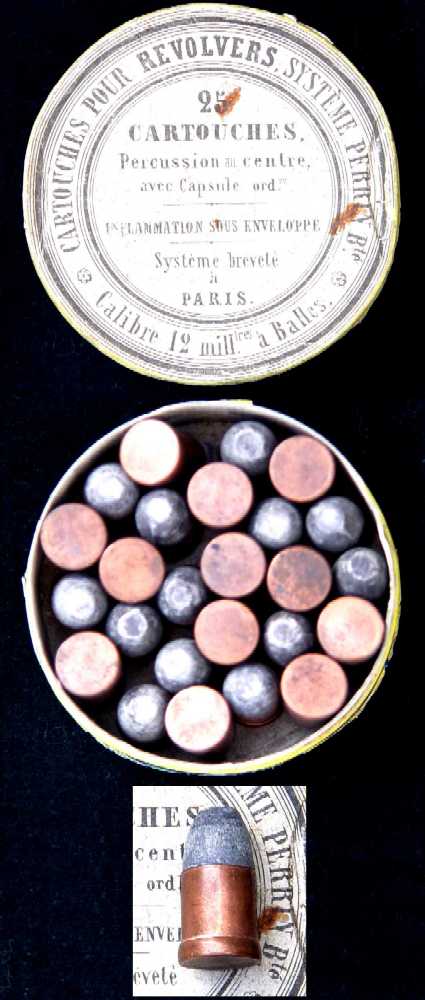 Here's
an unusual round cardboard cartridge box, this one containing twenty five of the relatively uncommon
copper cased 12mm
French thick rim cartridges. While the cartridges show up occasionally, I
had never seen the box, much less so many of the cartridges in one place.
This cartridge was intended for use in Lefaucheaux style revolvers that had
been converted from pinfire to centerfire, many of which were imported to
the United States for use by both sides during the American Civil War.
Here's
an unusual round cardboard cartridge box, this one containing twenty five of the relatively uncommon
copper cased 12mm
French thick rim cartridges. While the cartridges show up occasionally, I
had never seen the box, much less so many of the cartridges in one place.
This cartridge was intended for use in Lefaucheaux style revolvers that had
been converted from pinfire to centerfire, many of which were imported to
the United States for use by both sides during the American Civil War.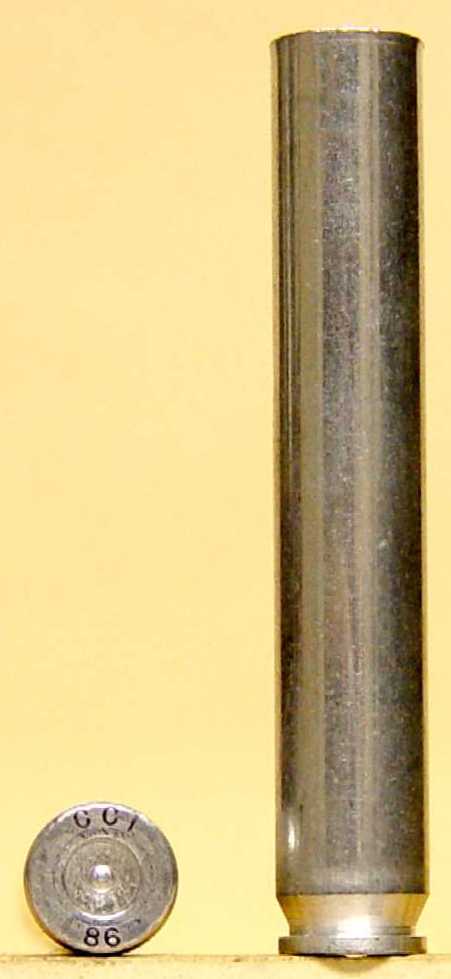
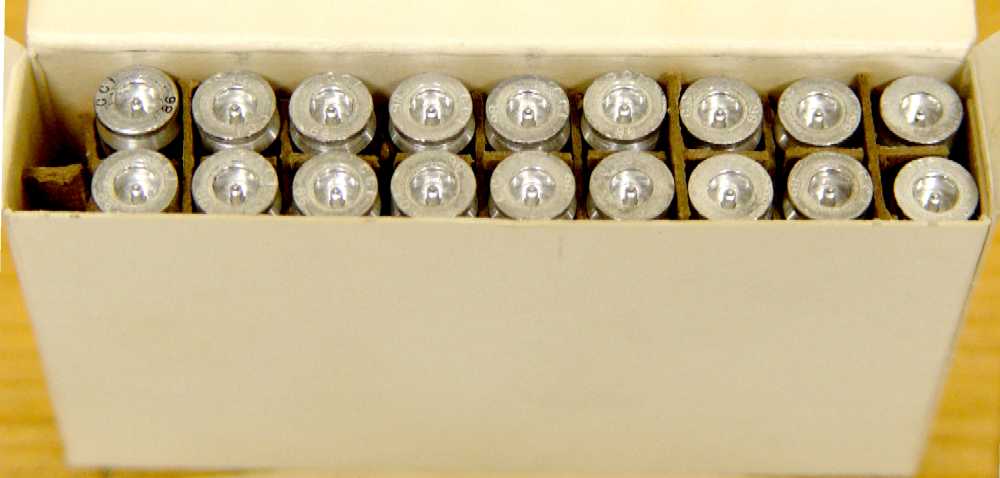
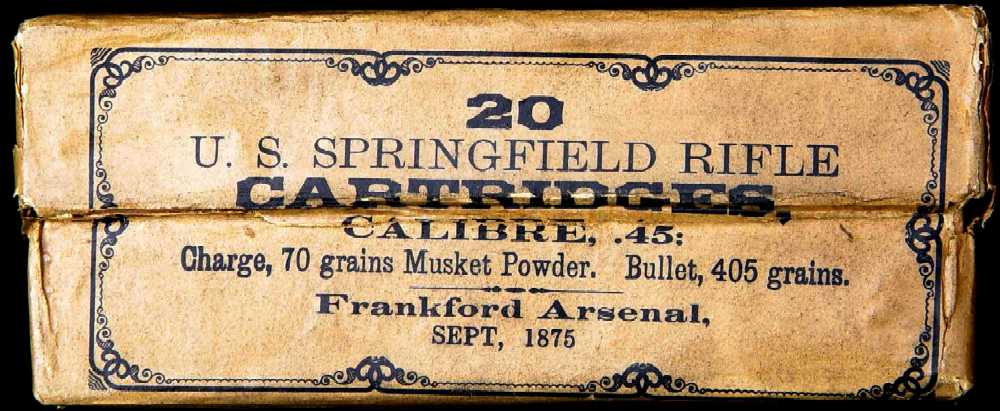 Here
are a couple more of what appear to be early Frankford Arsenal .45-70 boxes
which held Benet cup-primed cartridges made in September and October of
1875. The cartridges in these boxes would have been unheadstamped, and of
the type that had been in production since June of 1874, when the Ordnance
Department redesigned the copper case with a thicker rim and case wall to resolve a
problem experienced with earlier cartridges on which the rims had a tendency
to tear during the
Here
are a couple more of what appear to be early Frankford Arsenal .45-70 boxes
which held Benet cup-primed cartridges made in September and October of
1875. The cartridges in these boxes would have been unheadstamped, and of
the type that had been in production since June of 1874, when the Ordnance
Department redesigned the copper case with a thicker rim and case wall to resolve a
problem experienced with earlier cartridges on which the rims had a tendency
to tear during the
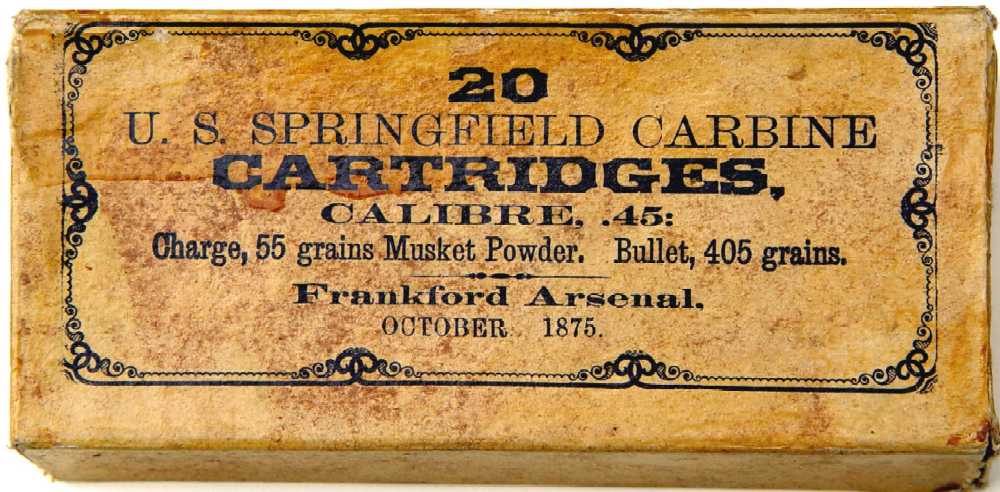 extraction
process. These improved cartridges still had the outward appearance of the
earlier cartridges, with the short crimps in the case walls that held the
primer cup in place, and would be the same as those used by Custer's troops
on his 1876 campaign that ended in the annihilation of his command at the
Little Big Horn. The September box would have held rifle cartridges, which
were loaded with 70 grains of black powder and a 405 grain lead bullet,
while the October box would have held carbine cartridges loaded with 55
grains of black powder and the same 405 grain bullet; the excess space in
the case being taken up by seven cardboard wads.
extraction
process. These improved cartridges still had the outward appearance of the
earlier cartridges, with the short crimps in the case walls that held the
primer cup in place, and would be the same as those used by Custer's troops
on his 1876 campaign that ended in the annihilation of his command at the
Little Big Horn. The September box would have held rifle cartridges, which
were loaded with 70 grains of black powder and a 405 grain lead bullet,
while the October box would have held carbine cartridges loaded with 55
grains of black powder and the same 405 grain bullet; the excess space in
the case being taken up by seven cardboard wads. 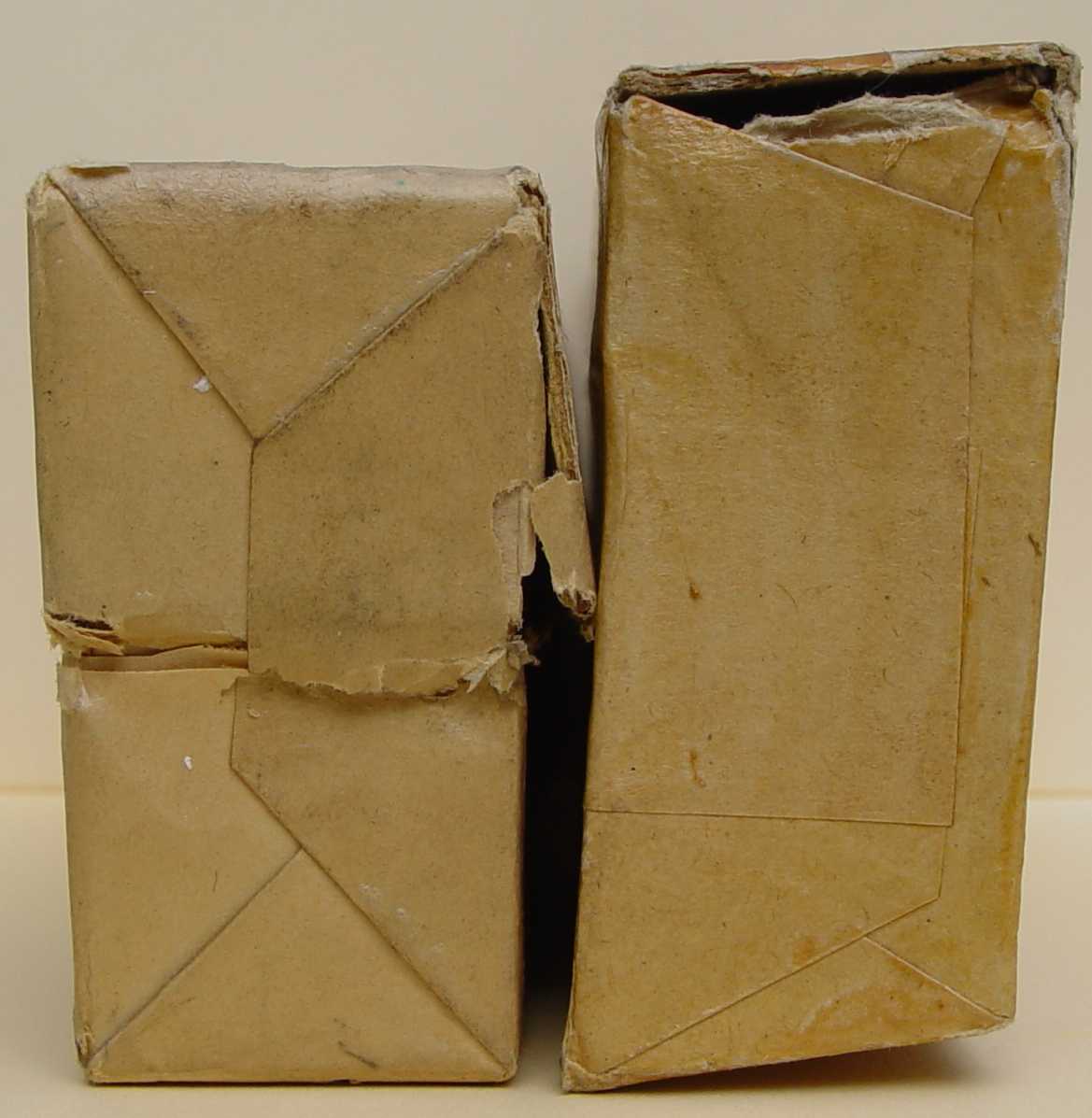 upper
portion of the front and the top of the box to be folded back along the
intact part of the wrapper at the rear edge of the top. As shown in this
view of the two boxes, the end of the incorrect box (on the left) has
corners that form right angles, while those on the correct box do not,
resulting in a box with an angled top and bottom that leans towards the
front when the box is sitting upright on its bottom. The purpose for the
angled top and bottom was to position the heads of the front row of
cartridges slightly above the rear row, allowing them to be easily removed
from the box one at a time.
upper
portion of the front and the top of the box to be folded back along the
intact part of the wrapper at the rear edge of the top. As shown in this
view of the two boxes, the end of the incorrect box (on the left) has
corners that form right angles, while those on the correct box do not,
resulting in a box with an angled top and bottom that leans towards the
front when the box is sitting upright on its bottom. The purpose for the
angled top and bottom was to position the heads of the front row of
cartridges slightly above the rear row, allowing them to be easily removed
from the box one at a time. 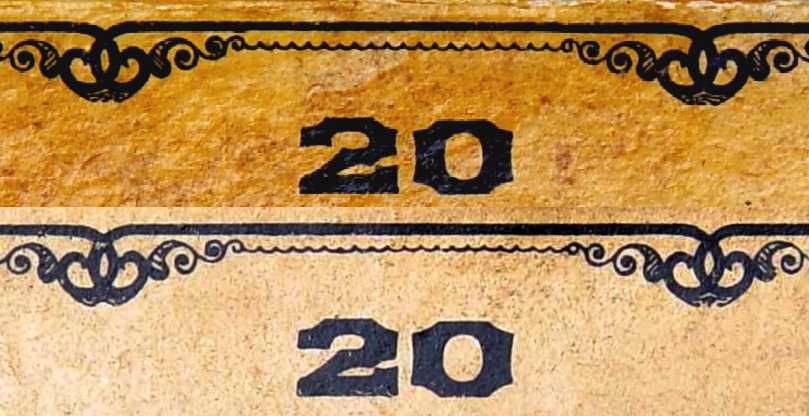
 reproduction,
then there is a good likelihood that there are others, making it imperative
that the buyer either know the person he is buying from, or get some form of
guarantee from the seller that will allow the return of the box if it is
found to be incorrect.
reproduction,
then there is a good likelihood that there are others, making it imperative
that the buyer either know the person he is buying from, or get some form of
guarantee from the seller that will allow the return of the box if it is
found to be incorrect.